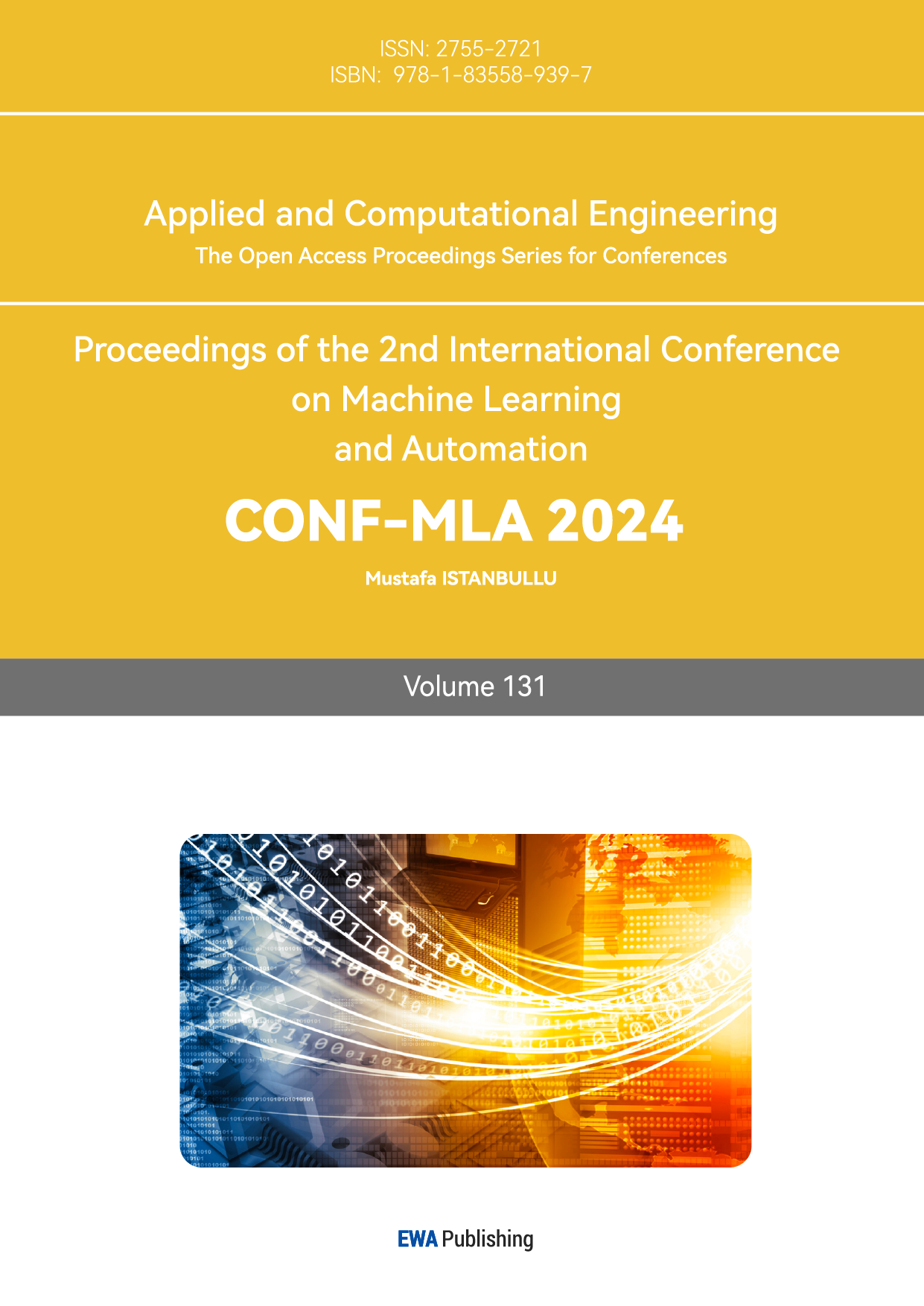1. Introduction
Industry 5.0 emphasizes interaction and collaboration between humans and machines [1]. Ensuring that employees are well supported as they perform specific tasks in the workplace is one of the many concerns that are faced by enterprises today. The lack of such support results in poor employee retention and related company costs. While the Metaverse digital ecosystem can accelerate the transition toward Industry 5.0, it needs to do so by allowing employees to create personalized value [2]. For that reason, this paper is focusing on various "Enterprise 5.0" social applications that may be performed more efficiently by leveraging innovative solutions in the Metaverse. The corresponding list of Metaverse Enterprise Social Applications (MESA) that we initially identified as part of our research includes the following:
- mesaConnect: supports the development of social connections between employees
- mesaFind: helps match experts within the enterprise.
- mesaMeet: facilitates private meetings with other employees
- mesaSolv: addresses problems encountered while working on projects
- mesaTrain: provides personalized training path
This paper is also exploring in this paper the delivery of MESAs to employees via a centralized palette of mixed reality widgets. Specifying these widgets using the Open Universal Scene Descriptor (OpenUSD) format facilitates combining them, which aligns well with our end goal of creating a supportive work environment that appeals to employees. To achieve this end goal, this paper aims to develop an extensible platform referred to as MESAVERSE that is designed to host and combine an extensible set of MESAs. The development of MESAVERSE is an ongoing effort that will lead to subsequent papers. In the following, at first this paper will discuss existing work related to our initial set of MESAs and delve into their design and implementation. We then relate to the minimum viable prototypes (MVPs) of our initial set of MESAs to demonstrate that combining them via MESAVERSE enables the creation of an Enterprise 5.0 ecosystem whose value is bigger than the sum of its parts.
2. Existing Work
This section is focusing on work that directly relates to the various MESAs introduced earlier.
2.1. mesaConnect
While today's workforce is becoming more diverse and inclusive, there are still social interaction-related issues that negatively affect organizations. For example, employees may not be able to develop contacts within the enterprise and may feel isolated and/or discriminated against. It is not easy today for employees to report their feelings without fear of being reprimanded or tagged in some way. Being able to develop contacts and report issues doing so is what mesaConnect focuses on. The lack of support in this area compromises efficiency and results in added costs to enterprises. Impact on efficiency is discussed in [3]. Another paper focuses on unfair treatment based on sex, race, age, disability, pregnancy, obesity, and so on [4]. Yet another paper delves into the reduction of productivity that results from employees being exposed to discrimination and suffering mentally or physically as a result [5]. As mentioned in another source, companies are often embroiled in costly legal matters, which affect normal business operations and result in added costs [6]. An interesting perspective is to consider how 3D virtual and augmented environments provide an easier way to oversee employees' behavior through digital techniques and, at the same time, employees benefit from a better user experience as they are immersed in the Metaverse [7]. Gathering reports of mistreatment that affect employees' performance is part of the process of detecting social interaction issues and providing diversity and inclusion training is a solution that helps minimize discrimination in the workplace [8]. This is especially true for employees who discriminate against other employees and do so unintentionally [9]. A company that embraces diversity and mitigates issues such as discrimination typically performs better as an organization and motivates creativity, which results in superior employee satisfaction [10]. Unlike the papers mentioned above, mesaConnect addresses social interaction issues while allowing employees to report these issues anonymously using a combination of innovative Metaverse technologies. mesaConnect also takes advantage of other MESAs supported by MESAVERSE such as mesaTrain and mesaMeet.
2.2. mesaFind
Numerous studies have highlighted the potential of the Metaverse in transforming enterprise operations. Research by [11] discusses how virtual reality (VR) is changing the future of work, emphasizing its role in immersive collaboration. Another research [12] explores the benefits and use cases of augmented reality (AR) in enterprise settings, including enhanced data visualization and interactive learning environments. Additionally, James Manyika and Kevin Sneader [13] examine the impact of artificial intelligence (AI) in the workplace, particularly in automating and optimizing business processes. These studies provide a foundation for understanding the potential of integrating expertise finders within the Metaverse. However, enterprises often face challenges in efficiently identifying and utilizing internal expertise to address specific issues. Traditional methods of expertise identification can be time-consuming and inefficient [14,15]. How to combine the expertise identification with the emerging technology remains a problem. In that case, mesaFind within the Metaverse can address these challenges, providing a more interactive and immersive solution for expertise management.
2.3. mesaMeet
Nowadays, people can use different applications to communicate with others, not only by voice transport, like phone calls but also can chat with others by video. People can choose the application that they prefer to chat with others. However, in the business, using applications to have a meeting is quite hard to accomplish. Not because the technology, the time allocation, and the work on employees make it hard to make employees have efficient communication with their seniors and colleagues. Even employees already reserved a meeting in the business, however, conferees are still possibly absent. Therefore, having a successful meeting is hard to control in real life. People will be late or even absent for their reasons, however, there is not a mature method to solve this problem. How to address this problem is a core that affects business development because it will determine the efficiency of communication and innovation. Based on the requirement, mesaMeet supports a platform that helps employees create a special meeting which can increase the efficiency of the business.
2.4. mesaSolv
Several studies have demonstrated that incentives and anonymity can greatly enhance the caliber of teamwork. In group decision support systems, anonymity can improve the quality of decision-making by reducing the fear of expression, getting rid of biases based on the source of comments, fostering the development of novel ideas, and enabling people to change their minds [16-19]. Additionally, anonymity promotes a freer interchange of ideas and a more critical examination of problems [20,21]. There are two main types of rewards as a motivating mechanism: equality-based and performance-based. Equality-based approaches can preserve team cohesion and unity but may result in issues with free riders, diminished individual initiative, and other productivity losses. Performance-based approaches have the potential to boost individual motivation and performance. In previous work [22], the method of how to reward individuals in an anonymous environment based on their contribution to the group effort through encryption technology has been discussed. This method is particularly suitable for implementation through blockchain technology, a new trend since the proposal of Bitcoin [23].
2.5. mesaTrain
Today, enterprise training increasingly uses VR and AR to create immersive learning experiences. Psotka highlights how VR/AR can simulate real-life scenarios and allow employees to practice their skills in risk-free environments, such as performing physical experiments that would not be feasible in reality [24]. Recently, Boeing used augmented reality to help assembly line workers do their jobs as shown in Figure 1, resulting in lower costs and higher profits [25]. Similarly, Walmart utilizes virtual reality to train employees in customer service, providing immersive training environments that increase employee confidence and improve customer relations.
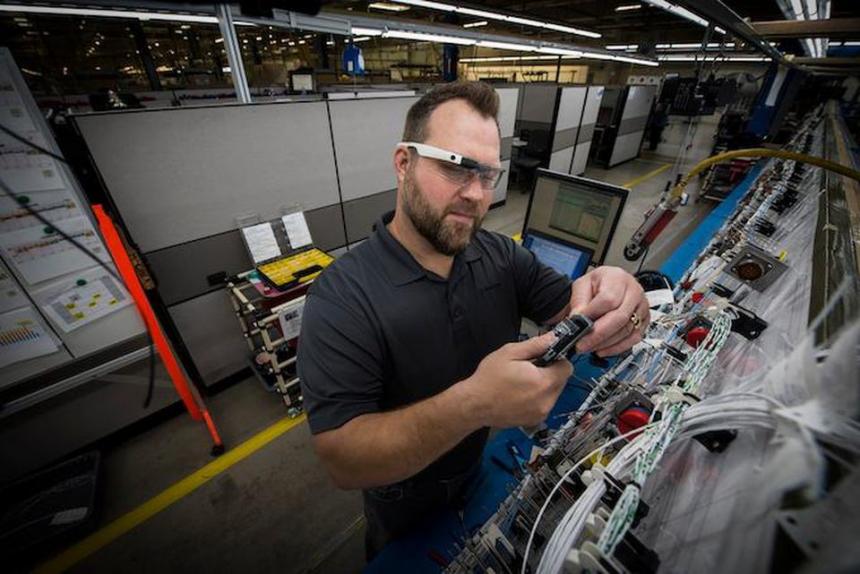
Figure 1. Boeing workers using AR [26].
Although technology continues to advance, there is still much room for improvement in the traditional training model. Current training programs lack continuous personalized feedback, fail to adapt to the industry's changing needs, and fail to integrate training phases effectively. To address these issues, artificial intelligence is used in the Metaverse environment to continuously monitor and analyze training results, provide real-time feedback, and create dynamic, adaptive training processes. Additionally, the benefits of immersive learning are leveraged to enhance employee training.
3. Design Methodology
In this section, this paper will go over exactly how each MESA works, and the steps involved.
3.1. mesaConnect
3.1.1. Rebuild Identity in Metaverse
The basic information of workers will be saved and preserved in the blockchain of Metaverse. The AR glasses served as a tool to create and view avatars. Considering possible discrimination on race and sex, workers have no limit on the choice of skin color, meaning they can choose colors, like green or blue, that do not exist in any race of human; also, they can set their sex as male, female, or neutral gender in gender. In this case, people are voluntarily showing their real cultural and gender identity or hiding them to avoid plausible discrimination. For the outfit, employees are given specific work clothes depending on their different positions and sections, since uniforms can improve human responsibility [27] and workers’ position and role in the company become more visible
3.1.2. Convenient Meeting Form
The virtualized image can be viewed by AR glasses. People will use a notification system in Metaverse to contact their partners and invite them to have a meeting if needed. The headset of AR glasses is in-ear and mutes’ people from outside voice, so their concentration will not be affected by the talk of their co-workers aside from them [28].
3.1.3. Detection of discrimination
Another function of the AR glasses is detecting cursed words during the interaction between workers. The detection of discriminatory epithets or manual reports from employees will automatically be sent to HR who will then check the memory to be aware of what is happening. In the memory, they will only have access to recognize who the subject person of the report is and deliver related measures to him or her if the reported information is true. Measures include warning (the first time) and inclusive diversity training (since the second time). The victims of discrimination will be given a chance to change special traits of their virtualized identity that possibly lead to discrimination.
Figure 2 presents the major funtion of mesaConnect:
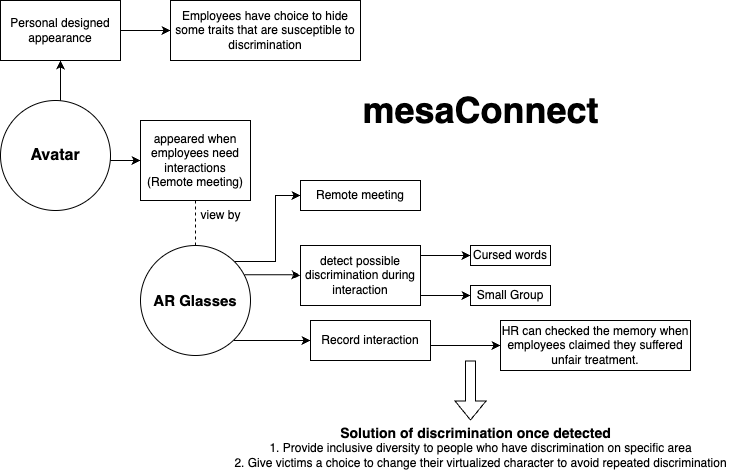
Figure 2. Process of Function of Avatar.
3.2. mesaFind
Below is a detailed description of the activities that are part of suggested process for finding experts in the enterprise using Metaverse's innovative technologies?
Firstly, the expertise finder requires the user to create a problem list. The AI then identifies the problem types, categorizing them into two groups:
(1) similar issues that have already been solved by someone.
(2) issues that are yet to be resolved
For the former, the system will automatically connect the user with the person who previously solved a similar problem (this person can be referred as the “expert”), provided the expert is available to assist. The user’s context and the problem details will be presented to this person, and both of them will be placed into a Metaverse-generated virtual meeting room. Here, they can discuss and share their ideas face-to-face to address the issue together. The entire problem-solving process will be recorded and stored as a video for future reference by others encountering similar problems. If the expert is unavailable, the recorded video of their previous problem-solving process will be projected for the user to study and find a solution on the user’s own. For unresolved issues, the problem will be sent to the company's community problem pool. The user’s context and the problem details will be presented in a video format. When someone produces a potential solution or wants to collaborate on the issue, both will be transported to a virtual meeting room for a face-to-face discussion to exchange ideas. If the problem is resolved at this stage, the process will also be recorded and stored as a video for future reference. Finally, the User needs to evaluate the person who helped you solve the problem. This feedback will optimize the mesaFind’s matching results, thereby improving the overall system. The progress of the mesaFind is shown in Figure 3:
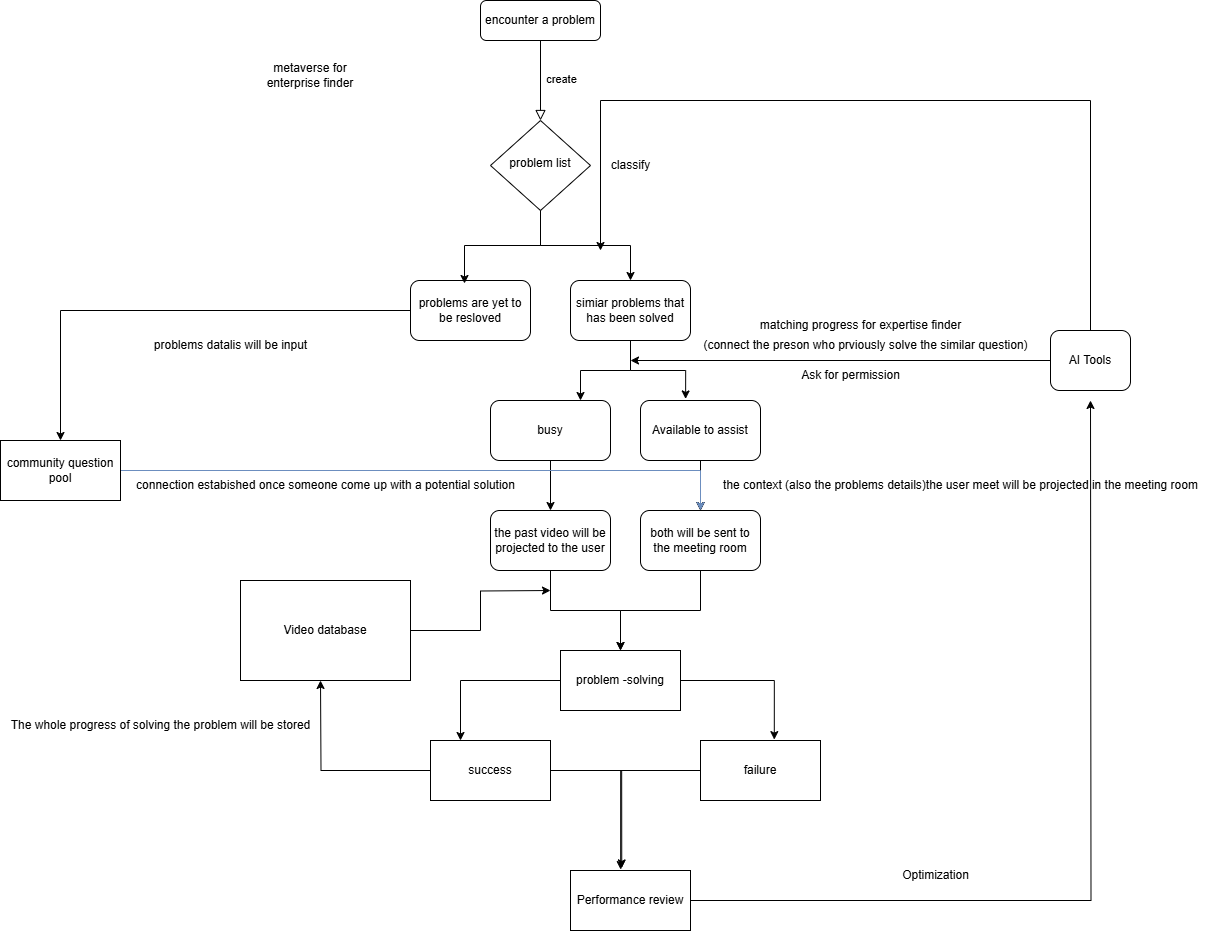
Figure 3. mesaFind progress.
3.3. mesaMeet
3.3.1. Employee interaction in the system
Person A wants to arrange a meeting with Person B but is struggling to find a quiet place due to disturbances in their surroundings. All available spots for a meeting are either occupied by other employees taking breaks or reserved for senior management personnel. A solution is proposed using a Metaverse system where A can send a meeting request to B. The system checks B's availability; if B is occupied with their tasks or in another meeting, the system notifies A accordingly. Alternatively, A can schedule the meeting in advance. If one party cancels, the system automatically notifies the other party and informs senior management. This approach prevents wastage of business resources and provides an opportunity for direct interaction with senior managers. When B receives the meeting request, they decide whether to accept or decline. A is promptly informed of B's decision. If accepted, both A and B are teleported to a quiet room where they can have a one-on-one conversation. This voice feature is not used in public environments, allowing individuals to maintain focus and enhance their immersive experience. The content also can be expresses in Figure 4
3.3.2. Principles of real-time voice technology
When implementing real-time voice communication, the process typically begins by capturing the user's voice signal through a microphone or other audio device. This signal is then digitized and compressed to enhance transmission efficiency and reduce latency. Subsequently, the audio data is transmitted over the Internet or a dedicated network using real-time protocols (RTP) to ensure packet sequencing and integrity.[29] At the receiving end, the data undergoes decoding and is processed with echo cancellation and noise reduction techniques before being played through speakers or headphones, enabling real-time voice communication between users. To secure the transmission of sensitive information, encryption technologies are commonly employed during the data transfer process.
3.3.3. Encryption of data
Encrypting meetings by using RSA can shun the record stolen by competing opponents. Additionally, due to the RSA's unique characteristics, which are akin to those of asymmetric encryption, it ensures that both employees and management can access and review this video. In RSA, all the data can be present by a unique number, both encryption and decryption will outcome a number. The encryption number (En) can be calculated by E(encryption) to the power of (called m) mod N, and decryption D to the power of (En) mod N. N is the same for both equations [30]. Compared with symmetric encryption, it is harder for our business opponents to hack into our system.
3.3.4. Special aspect of RSA
The distinguishing feature of RSA encryption lies in its use of asymmetric cryptography, where two distinct keys are employed for encryption and decryption. The public key, comprising an exponent e and a modulus n, is widely shared and used by anyone to encrypt data. [30] Conversely, the private key, including another exponent d derived from e and n, remains confidential and is utilized for decrypting messages. RSA's security is underpinned by the computational complexity of factoring large composite numbers, which ensures that deriving the private key from the public key without knowing the prime factors of n is computationally infeasible.
3.3.5. Video evaluation
In the backup video, AI will evaluate the video, from different aspects to analyze the degree of performance in the meeting. To the business, the main aspects that employees show and can be present in the meeting are communication skills, innovation and creativity, and their understanding of business policies and decisions. In businesses, all these abilities can be presented by oral speaking when employees are having a meeting. AI can determine the efficiency of language, which is the idea presented, by using big data, and prompt words to identify the efficiency of language that employees use. Besides, counting the time employees spend speaking shows how active they are. Finally, based on the analysis of the video and the times of meetings that an employee participated in, which will support a quantified standard help seniors to have a comprehensive understanding of their employees and develop business.
Figure 4 shows the process of invitation, regarding how to send a meeting request and the whole meeting process.
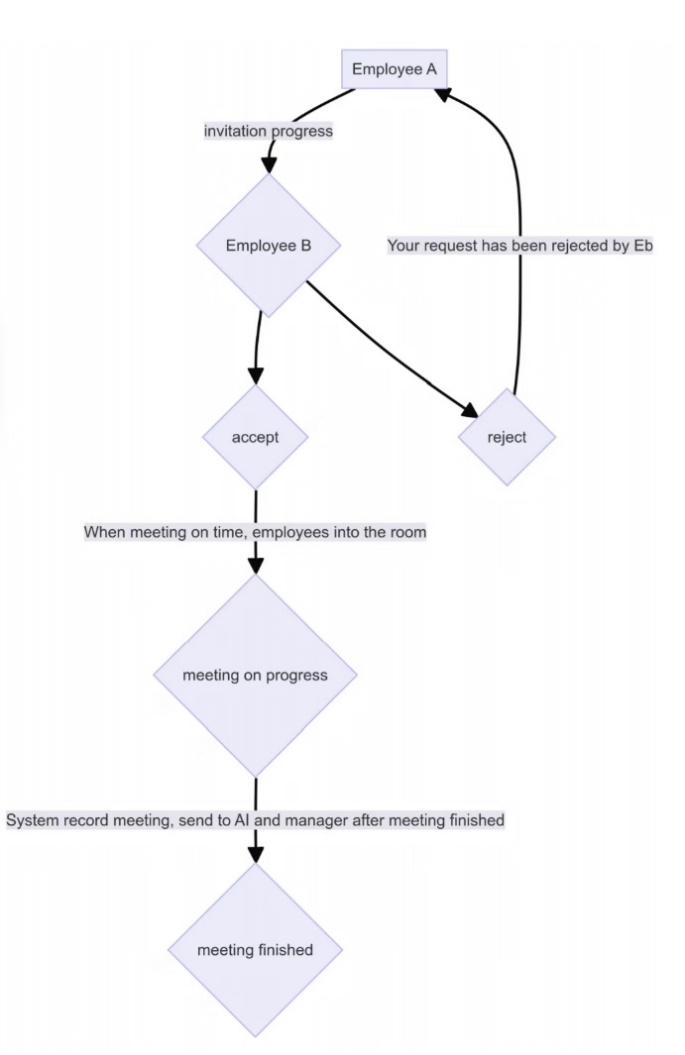
Figure 4. Process of invitation.
3.4. mesaSolv
mesaSolv is a blockchain-based group decision support system (GDSS) designed for the Metaverse workplace. The purpose of mesaSolv is to streamline the process of problem resolving, enhancing high-quality teamwork, optimizing individual performance, and ensuring fair distribution of credit.
Anonymity: In mesaSolv, users are represented by an anonymous agent, a unique identifier that conceals their personal information and identity. All interactions within the platform are conducted through these anonymous agents, ensuring that users can participate without fear of judgment or bias based on their real-world identity. This encouraged more open communication so that all voices are heard and considered equally, building a problem-focused atmosphere and enhanced engagement.
Problem Resolving: Collaboration: Users can report the problems they find and allow other users to join in the problem solution. The process is supported by certain features to improve efficiency, such as discussion forums, remote meetings, AR/VR information displays, and other AI-powered productivity tools. As new users join in the discussion, AI will provide them with the context of the issue and reduce the time for understanding the current issue.
Contribution Evaluation: Once a problem is solved, the system's AI analyzes the contributions made by each participant. Contributors can rate each other's contributions, providing subjective feedback that is also considered in the AI's analysis. This feedback loop helps to improve the system's decision-making processes over time. This could involve assessing the quality, relevance, and impact of each contribution.
Performance-based Reward: The system uses blockchain technology to manage rewards. This ensures transparency and security in the distribution of rewards. Users link their wallet addresses to their anonymous agents, allowing them to receive rewards directly to their wallets. The blockchain records the rewards transactions, providing a tamper-proof record.

Figure 5. Design of Incentive Mechanism.
3.5. mesaTrain
The training system integrates multiple perspectives, including HR professionals, managers, and employees, each playing a crucial role. HR oversees training programs, collects, and analyzes data, and ensures alignment with enterprise goals. Managers assign tasks, monitor progress, and gather feedback. Employees actively participate, engage in personalized learning paths, and provide feedback for continuous improvement. The whole process is shown in Figure 6 below.
3.5.1. Determine Skill Requirements
The first step is to identify essential job skills systematically. In the Metaverse, AI analyzes job descriptions, industry trends, and performance data to create a dynamic skills catalog, regularly updated to reflect changes. This ensures all stakeholders are aware of the necessary skills. While AI is powerful, human intervention remains essential. By aligning skill requirements with enterprise goals, HR professionals can ensure that training programs are relevant and targeted. Addressing skill discrepancies is critical for strategic decisions and success, as noted by Borner, making this step crucial for aligning training with business needs [31].
3.5.2. Identify Employee Skills Based on Tasks
Next, employees assess their skills through system-generated self-assessments based on the Skills Catalog, focusing only on required skills since manually asking employees to assess themselves thoroughly often becomes inaccurate considering vanity and time-consuming. Automating this process increases accuracy and efficiency, helping to identify knowledge gaps and areas needing development.
3.5.3. Gap Analysis
The system then compares self-assessed skills with the required levels, identifying specific skills needing improvement. This allows AI algorithms and HR professionals to tailor training programs to each employee's needs, enhancing learning effectiveness.
3.5.4. Select Training
According to the gap analysis, the system recommends relevant training courses. The AI-driven system will combine corporate culture and the company's past data to match employees' skill gaps with personalized training options. The targeted enterprise training courses enhance training efficiency and improve employees' work performance.
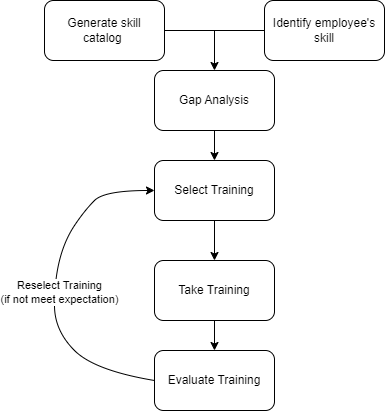
Figure 6. Personalized Training Process.
3.5.5. Deliver Training
Training programs use VR and AR to simulate real-life skill practice scenarios to create immersive, interactive learning experiences. When the role is the customer, the 3D scene enhances the interaction and communication with the customer and thus better maintains the customer relationship. The positive feedback and support employee received increased their confidence and skill retention. Psotka stressed that VR and AR significantly enhance learning interactions by providing realistic experience environments [24].
3.5.6. Evaluate Training Suitability
Finally, the AI-driven system continuously evaluates the effectiveness of the training. By comparing an employee's post-training skill levels with the expectation, the AI-driven system will give feedback on the effectiveness of the training and provide additional training based on the assessment. Ongoing evaluations are conducted to improve training programs and ensure employees acquire the necessary skills. This is consistent with the organizational goals emphasized by Eseryel [32].
4. Implementation Approach
4.1. Underlying Engine
The underlying engine is critical to enable the integration and smooth operation of components within the MESAVERSE platform. It provides developers and administrators with a unified interface and toolset to support platform building, managing, and extending. This engine must be robust and scalable to cope with the complexity of the MESAVERSE environment. The implementation consists of fifteen tables and six modules supporting existing systems. Each module is self-contained, contains the information needed to support its functionality, and is designed to be easily extensible to meet future needs. The current six modules include five main service modules: mesaConnect, mesaFind, mesaMeet, mesaSolv, and mesaTrain, as well as a pseudo-identity module that supports these modules, which combines personal enterprise data.
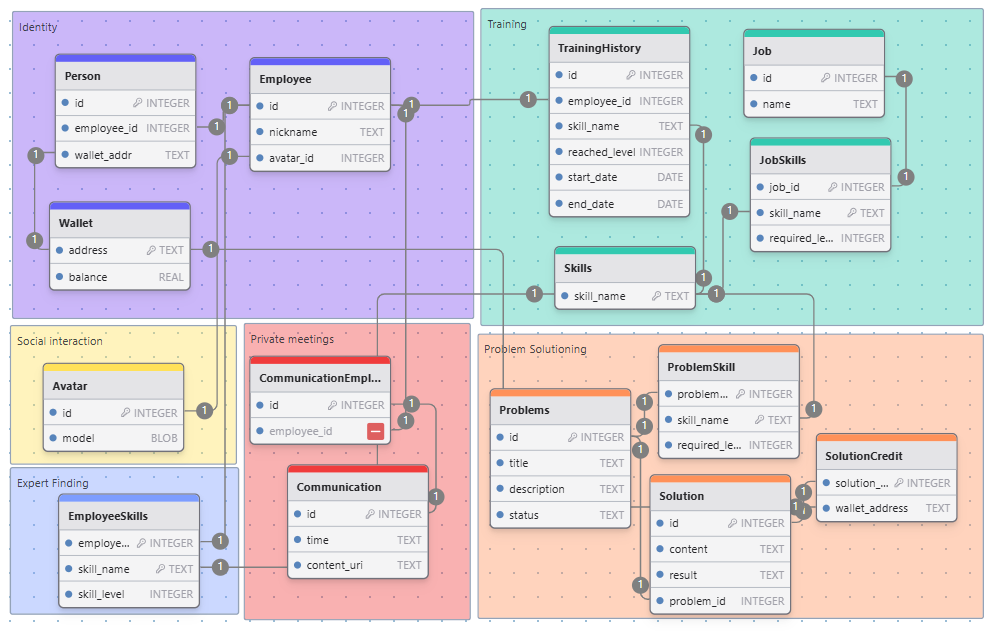
Figure 7. Overall Database Design.
These services are vital in enhancing enterprise social computing functionality and user experience, facilitating collaboration, skill development, and problem-solving, so the tables are designed to be functionally oriented as shown in Figure 7.
4.1.1. Identity
The Identity service module models how employee information is used within an organization. The Employee table stores each employee's unique identifier, nickname, and avatar ID, ensuring a personalized experience. The People Table associates employees with their digital wallet addresses, facilitating secure transactions, and these addresses are personally owned with no privacy breaches involved. On the other hand, the wallet table records the balance and address of the employee's wallet, ensuring smooth financial interactions. Overall, the module simulates the independent storage and use of personal and business information with privacy and usability in mind.
4.1.2. Social Interaction
The Social Interaction service facilitates employee interactions and is primarily used to support the mesaConnect service. In the initial phase, the system stores information about employee interactions mainly through avatar tables for subsequent analysis and optimization. In the future, the module will be responsible for recording, storing, analyzing, and improving the social interaction experience of employees, with a focus on reducing discrimination, promoting inclusiveness, and ensuring that all employees feel valued and respected by the company.
4.1.3. Expert Finding
The Expert Search service uses mesaFind to help identify employees with specific skills or expertise. The job table lists the various roles in the organization, and the JobSkills table links these roles to the required skills, thus helping to match employees with suitable tasks and projects. This system optimizes resource allocation and facilitates collaboration between skilled employees.
4.1.4. Training
Training services are specialized for mesaTrain's employee skill development and tracking. The TrainingHistory table documents the training courses each employee has attended, detailing the skills learned, levels achieved, and training time. On the other hand, the EmployeeSkills table outlines the skills acquired by the employee and their level of proficiency. The Skills table serves as a catalog of the skills available within the organization. At the same time, the JobSkills table outlines the skills required for each position, ensuring that employee competencies match the enterprise's needs.
4.1.5. Private Meetings
The private meeting service is used to resolve issues between employees and promote collaboration, which is a core feature of mesaMeet. The communication table records information exchanged between employees, including timestamps and URIs for shared content. CommunicationEmployee table links employees to their communication records for easy tracking and management of interactions. This framework helps facilitate collaboration and enhance the social experience within the enterprise.
4.1.6. Problem Solving
The Problem-Solving service is designed to leverage mesaSolv to respond effectively to employees' challenges. The Problems table is a repository of all questions asked and contains the title, description, and status of the problem. The ProblemSkill table associates the specific skills needed to solve the problem with the question. The Solution table records suggested solutions and their outcomes, and the SolutionCredit table tracks and rewards employees for successful problem-solving. This structured approach improves the ability to collaborate within the organization, thus effectively facilitating employee communication.
4.2. mesaConnect
4.2.1. Start by Avatar Design
Once the human resources receive employees’ basic information included in the resume and interview, the data is saved and protected in the blockchain of the Metaverse. Workers will be given AR glasses and use it to design their own virtualized identity. After they put on the glasses, through techniques of augmented and virtual reality, an initialized character will appear and ask them to enter their unique nickname. The following step is to choose any color on the spectrum as their avatars’ skin color and what sex they want to be: male, female, or neutral gender. If they want their virtual appearance to be more personal, they can tap in the detail bottom on the left to switch the shape of their face, eye, nose, hair, body shape, and so on. After they have clicked the confirm button, their design sections are finished and there will be a bubble pop out that asks people to enter their occupation, so the system can provide specific outfits for them.
4.2.2. Convenient Meeting Form
Once people need to discuss with their partners from any place of the company, they can open the chat button search for the names of people and send invitations; then they wait for others' mini avatars to appear on the desk or a rejection with reason. In the sight of the partners, they will see a notification in the up-right of their virtual scream and two buttons of agree and reject, respectively. Assuming the invitation is approved, the avatar of employees will appear at their partners’ working table and show people’s speech, gestures, facial and physical movements, and emotions. People sitting around will work as normal for the reason they are all muted by the headset of AR glasses that ban them from listening to other people’s discussion.
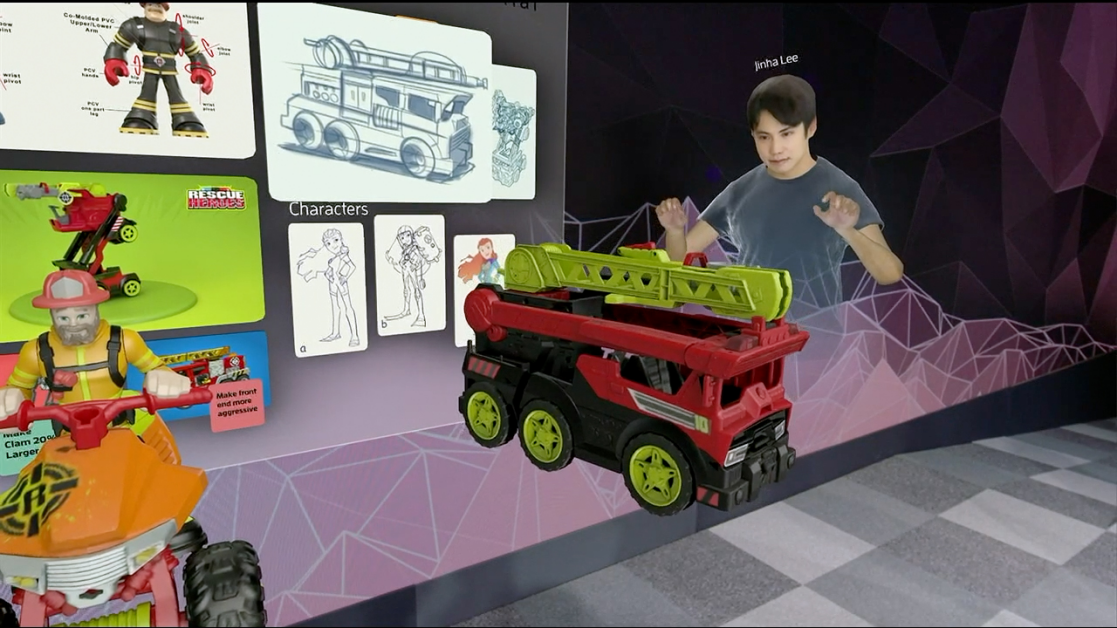
Figure 8. Meeting in Augmented Reality [33].
The process of using ESC service people cooperating with others’ avatars will be similar to the meeting platform shown in Figure 8 provided by Spatial, a company focused on facilitating remote interaction in the workplace through augmented and virtual reality.
4.2.3. Detection and Solution to Discrimination
The vocab detection system that takes the example of what today’s social media used to regulate the video content posted on social media will be utilized to discover abusive language. As long as people speak cursed words in the workplace and are caught by the service, a report of possible unfriendly behavior will be sent to HR. Besides, employees can report manually including time range about discrimination or isolation in the workplace. After receiving an anonymous report from the message system in the Metaverse, HR will check the reporter’s memory in the time range of events happening saved in the blockchain at the bottom of the report to see if there are discriminatory epithets or performance during interaction or small groups that exclude a specific person. In the memory, the personal traits of the victim avatar (if appears in memory) will be hidden, which means HR can only know and recognize which avatar is this report for. Based on the memory, they will decide whether the reported information is accurate by clicking confirm or refuse bottom at the end of memory. The report moved into the archive in the Metaverse after choosing to refuse or if the staff confirms this discrimination, the ESC service will deliver a warning bubble of inappropriate behavior pumped out in the sight of the person. For the second time confirmed discrimination report, this employee will be identified as the one that needs inclusive diversity training by the training system of the ESC service. He or she will receive a training notification at the top of their virtual screen. In addition, the victim will also get a notification of the result of the audit. If they were truly mistreated, there will be a bubble on the right side of the notification that allows them to change the design of the avatar after tapping it.
4.3. mesaSolv
4.3.1. Underlying Database
An underlying database is crucial for all applications. For structured data storage, MySQL or Microsoft SQL Server will be used. For unstructured data, NoSQL databases will be built using technologies like MongoDB, which are useful for handling large volumes of user-generated content. All the data will also be stored in a data warehouse like Amazon Redshift or Google BigQuery, for data analytics and reporting.
4.3.2. Collaboration Platform
The collaboration platform is built using front-end frameworks such as React or Vue.js to create a dynamic and interactive user interface. These will be paired with back-end frameworks like Node.js with Express or Ruby on Rails to support the system. RESTful or GraphQL APIs will be used for smooth data interchange.
4.3.3. Interaction System
OAuth 2.0 or OpenID Connect will be used to secure the interaction system through secure login and authentication. User permissions will be managed using JSON Web Tokens (JWT) or role-based access control (RBAC). Real-time communication will be implemented through WebSockets or Socket.IO.
4.3.4. Solution Evaluation
AI models will be built using TensorFlow or PyTorch to evaluate contributions. NLP tools will be employed for analyzing and understanding text data through fine-tuned fundamental models. Data visualization will be achieved using D3.js or Chart.js to create visual representations of evaluation results.
4.3.5. Blockchain Integration
Integration of mesaSolv with blockchain platforms like Ethereum or Hyperledger Fabric will be implemented for smart contracts and decentralized applications. Wallets such as MetaMask or Ledger will be used to connect user wallets to the platform. For smart contract development and testing, tools like Solidity or Hardhat will be used. The interplanetary file system (IPFS) will be used for storing and accessing blockchain-related data in a decentralized manner. mesaSolv is deeply integrated with other MESAs. For example, mesaConnect provides the agent for user interactions, mesaMeet is used for private meetings and discussions, and mesaFind allows users to easily find people capable of providing help.
4.4. mesaMeet
If a company operates in a virtual world, AR and VR could excel as mediums and are well-suited for presenting the virtual world. To make the characters and office scenes in Metaverse more realistic, Unity's facial recognition and 3D engine can create office scenes in software. unity can capture the appearance of each employee through facial recognition, automatically generate portraits, and then project them to each person's job. When employees need to choose who to meet, there is a list on the side of the screen that displays the name and status of everyone in the company. When an employee wants to have a meeting with another employee, they can select that employee from the list. When the employee is busy, the status bar is red. When an employee is idle, the status bar is green. Employees who are not online are displayed in gray and cannot be selected. Next, if the employee who received the meeting invitation agrees to the meeting invitation, the meeting initiator will receive a green notification indicating that the meeting has been scheduled, while the meeting initiator will receive a red notification indicating that the meeting has been declined. Declining the meeting will send a notification to the company's manager, who will have the name of the initiator and attendee displayed on the side of the screen and be told who declined the meeting.
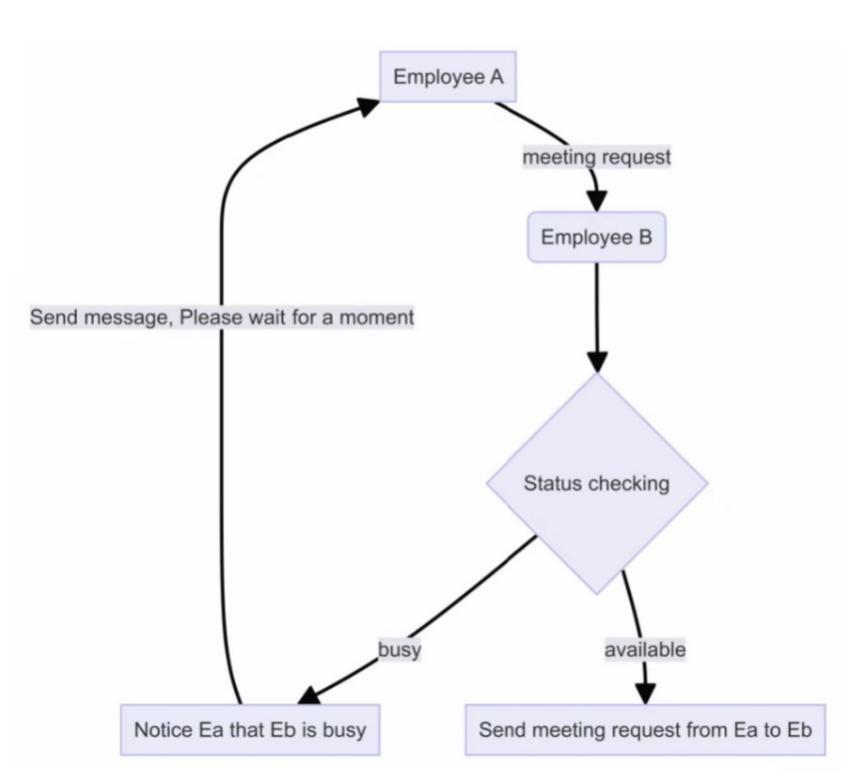
Figure 9. Invitation process.
The invitation progress as shown in Figure 9. When the meeting is generated and the agreed time arrives, the Avatars of all meeting participants are automatically transferred to the same room. To ensure that information is transmitted only between participants, RTP is used to facilitate the transmission of information. Ensure that the meeting will not be eavesdropped and entered by others. After the meeting starts, the entire meeting room will be forbidden for other people to enter. The employees in the meeting can exit the meeting at any time, but there is no way to enter again. Meetings are automatically recorded and backed up to the cloud. After a meeting is saved to the cloud, the RSA encryption mode is used to encrypt all the meeting information. All data backed up in the cloud is stored in binaries that computers can read. RSA can encrypt the data stored by the computer mathematically, because of the existence of the public key and private key, it is difficult for hackers without relevant information to invade the database inside the meeting content, which can ensure the security of information. Finally, after the video is saved, the AI evaluates the employee's performance. AI can use the most popular Open AI-GPT on the market. AI can extract the words or sentences spoken by employees in the meeting and find out whether employees' speeches can express a complete meaning in the past database through Machine Learning. From this, the management personnel can judge whether employees have made deep thinking in the meeting, also can determine the passion of employees have. HR can use the data given by AI to have a more comprehensive view of employees. Figure 10 shows the concept of meeting room in metaverse.

Figure 10. Metaverse private room [34].
4.5. mesaTrain
AI and Natural Language Processing (NLP) tools such as OpenAI GPT-4 and IBM Watson are employed to achieve the first objective. Key skills are extracted by analyzing job descriptions, industry trends, and historical data. This data is processed using SQL databases and AWS databases to create a comprehensive catalog of skills. This directory is integrated with a metadata platform that allows HR and managers to review and update it regularly. VR technology will be used to build more intuitive interfaces where people can manipulate data through voice commands and gestures. Like the Citi Hololens application shown in Figure 11, the skill categories are visual bubbles, with larger bubbles representing more relevant skills. Selecting a bubble will display a list of relevant skills, with additional information on the side of the interface.
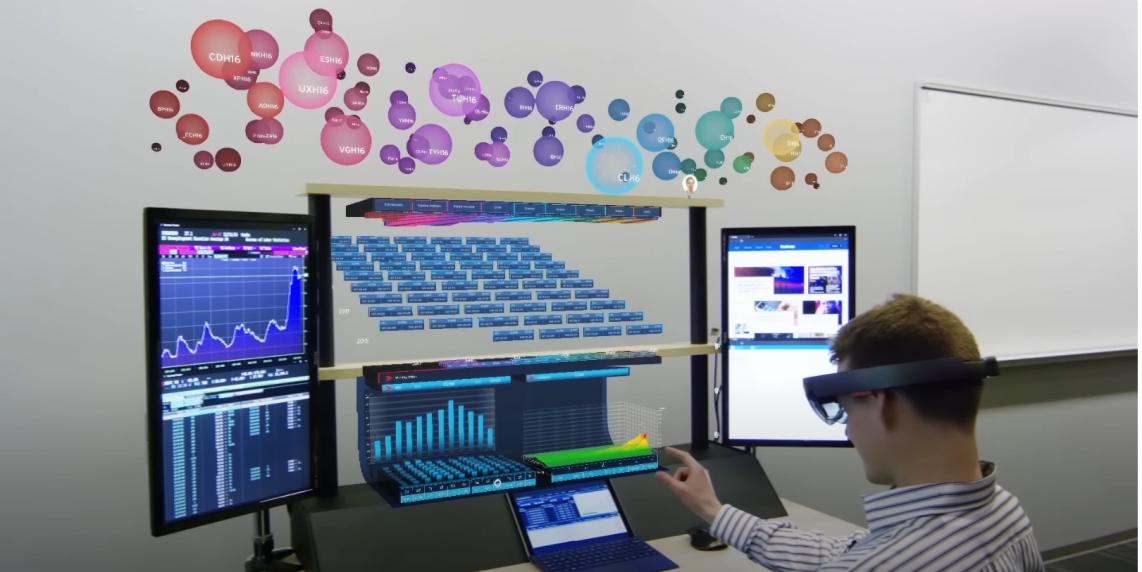
Figure 11. Citi Hololens [35].
In the second step, automated survey tools such as Survey Monkey and Google Forms generate employee evaluations based on a skill list. Employees use AR/VR devices to enter the virtual reality world and answer relevant questions through interactions. This data is securely stored in cloud solutions such as Amazon S3 and Google Cloud Storage. This way, accurate and valid data can be collected to facilitate gap analysis. Next, data analytics tools such as Tableau and Microsoft Power BI compare self-rated skills to those in the catalog. Using TensorFlow and PyTorch's AI algorithms, each employee's gaps in a specific skill are identified, and a detailed analysis report is generated. HR and corresponding employees have access to these reports, which are presented as holograms in the virtual world so that employees can more clearly see the areas needing improvement. Then, an AI-driven recommendation system using Scikit-learn analyzes the identified skill gaps and suggests appropriate training courses. These recommendations are visually displayed in the meta-network to provide employees with personalized training plans. The recommended courses are integrated with learning management system (LMS) platforms such as Moodle and Canvas, allowing employees to register for and access courses, articles, and videos from the meta-network. The system also recommends experienced employees as training instructors in holograms within the visual interface. The training program leverages VR and AR technologies like Oculus Rift, Microsoft HoloLens, Unity3D, and Unreal Engine to simulate real-life scenarios, enabling employees to practice their skills in a safe and immersive environment. Figure 12 shows a possible visualization of the new training environment. For hands-on work, employees can communicate with the relevant mentor via webcam for better guidance. When employees have specific problems that need guidance, 3D holographic projection technology such as Microsoft's Holoportation allows employees and mentors to simultaneously enter the same work scene. LMS tracks the progress and completion of training, updating and recording the staff training results in real-time.
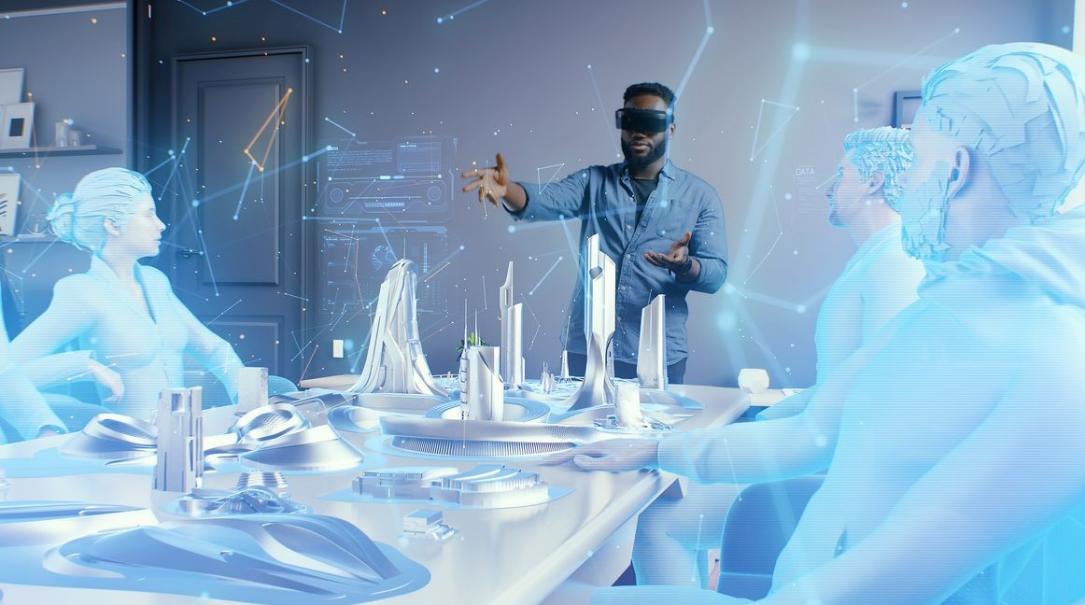
Figure 12. VR Training [36].
After training, OpenAI GPT-4's evaluation system continuously monitors the results. Data analysis tools such as Tableau provide real-time feedback and generate detailed evaluation reports, which are recorded in a visual interface that HR and employees can access at any time. In addition, employees can complete training courses on the virtual interface in their preferred order based on the training list. Continuous feedback and updates on training evaluations increase training efficiency, and employees can see evaluation results and areas for improvement in a visual interface. HR professionals use the system assessment to update and add relevant training courses.
4.6. mesaFind
This section outlines the approach for using the Metaverse with mesaFind to create a detailed problem list, identify and engage relevant experts, and facilitate ongoing collaboration, including expert feedback. Virtual collaboration platforms like Microsoft Mesh and Spatial.io can be used to create and manage problem lists within the Metaverse. Tools like Google Workspace and Microsoft Teams can be integrated for seamless document editing, while interactive whiteboards such as Miro support brainstorming and prioritization. AI-powered search tools like Elasticsearch and Algolia can scan enterprise databases and knowledge systems like Confluence or SharePoint to quickly locate relevant information. For data visualization, VR/AR tools like Oculus Quest and Microsoft HoloLens allow users to interact with complex data in immersive ways. VR-compatible dashboards from tools like Tableau or Power BI can be embedded for interactive visualizations. The process, including expert collaboration, will be documented through video, as illustrated in Figure 13 and Figure 14.
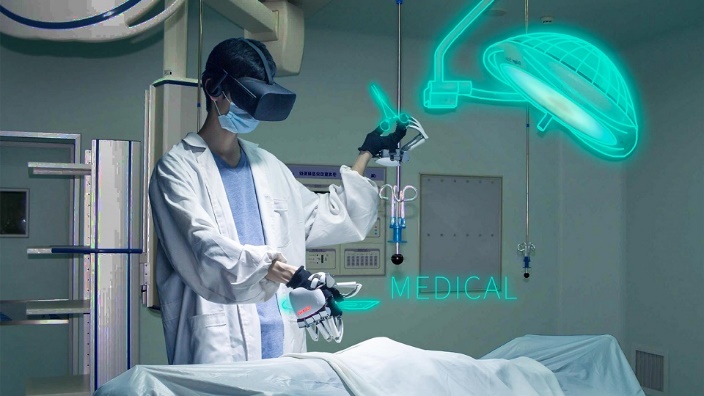
Figure 13. Remote expert [37].

Figure 14. Remote surgery [38].
AI algorithms built using frameworks like TensorFlow or PyTorch can analyze expert profiles, past projects, and user ratings to find the best match for each problem. Platforms like Starmind can be integrated to leverage AI for intelligent recommendations based on data from sources such as LinkedIn APIs and internal HR systems. Virtual meeting platforms like Zoom VR, and Virbela can create immersive meeting rooms. The entire problem-solving process will be recorded with tools like OBS Studio and stored as videos for future reference. Virtual forums like Discourse or Vanilla Forums can be established within the Metaverse to support community discussions. Trello or Jira can serve as bulletin boards for posting unresolved problems and tracking progress. Platforms like Workplace by Facebook or Slack can facilitate collaboration and discussion, harnessing the collective intelligence of the organization. Interactive feedback forms, such as SurveyMonkey or Google Forms, will be integrated into the virtual environment to gather evaluations. A rating system will allow users to assess expert performance and analytics tools like Power BI or Tableau will analyze feedback to optimize matching algorithms and improve mesaFind continuously.
5. Value Analysis
In this section, we describe the value our MESAVERSE brings to enterprises in the Metaverse.
5.1. Enhance Engagement and Adaptability
The MESAVERSE utilizes VR and AR technology to greatly increase employee engagement and learning through immersive experiences. By allowing employees to practice their skills in immersive scenarios, this novel approach increases employee excitement, focus, and learning effectiveness, thus increasing intrinsic motivations, as Guillen emphasizes [39]. MESAVERSE not only creates a more engaging and interactive environment, but it also enriches the learning experience and motivates employees to put more effort into their training. In addition, the AI recommendation system, mesaTrain, can tailor training courses to meet the expectations and skills gaps of each employee based on performance data, career goals, and changing job requirements. As Borner points out, employee skills need to evolve with the industry [31]. Therefore, mesaTrain's regular evaluations and real-time updates keep training relevant and effective, aligning it with the changing needs of the enterprise and employees, and highlighting MESAVERSE's adaptability to the industry. Additionally, in mesaConnect, users can create personalized avatars, and through mesaMeet, they can meet and communicate across geographical restrictions, further demonstrating MESAVERSE's adaptability.
5.2. Reduce Discrimination
MESAVERSE decreased discrimination in three ways. Firstly, as one of the methods to avoid discrimination is hiding traits that are susceptible to people with less inclusive and diverse, the metaConnect engenders employees to present as personally designed avatars. Therefore, they are offered a chance to cover traits that they are not confident or concerned about. For example, people can choose their gender to be neutral to avoid sexual discrimination which they have no method of doing in reality. MesaConnect also provides a language detection system that aims to discover possible verbal discrimination and a recording service that saves people’s interactions in the blockchain of the Metaverse. Through these functions, monitoring and regulation of discrimination become more advanced and clearer. Thirdly, both mesaConnect and mesaSolv provide users anonymous way to give feedback on unfair treatment, like discrimination, they encountered in the workplace. As the identity of the reporter is not revealed, they, as victims, are protected. Compared with companies that have transparent or leaky reporting systems, companies using MESAVERSE give their employees covert and comprehensive opportunities to speak out their thoughts and mistreatment. Organizations that are more accessible to the voice of employees can achieve better achievement on attracting and preserving their people.
5.3. Maintain Fairness
In the modern workplace, the importance of fairness cannot be overstated. It serves as the foundation for a healthy and productive work environment. By utilizing MESAVERSE, companies can ensure that every employee’s voice is heard and valued, regardless of their position or background. This anonymity fosters an environment where ideas are judged on their merit, not the person presenting them. Moreover, the performance-based incentive system in mesaSolv encourages employees to excel, knowing that their hard work will translate into tangible rewards. This not only boosts individual motivation but also contributes to the overall success of the organization, creating a win-win situation for both employees and the company.
5.4. Protect Data Security and Privacy
Security is a very important part of all our designs. In MESAVERSE, employees are represented as avatars, and all employees can design a unique image and use a nickname. In this scenario, everyone's image in real life can be protected. Even though employees entered their identity information when they joined the company, all personal information was protected by encryption. Even if other companies investigate, they can only investigate the image and information of each person in Mesa. At the same time, all meeting information is recorded and has a backup of the data and is also protected by asymmetric encryption. It can effectively prevent hackers from stealing information, but also ensure that the company's internal personnel have the right to view records at any time. Also, in fair trade, the mesaSolv part, because of the application of blockchain, enterprises can use the property of, which is anonymous. All our designs are protected by multiple encryptions, anonymous, RSA, and avatar all these can protect business data and ensure its safety.
5.5. Increase Efficiency
Using Mesa like mesaConnect enables remote collaboration with colleagues from different countries seamlessly, saving time and resources by reducing the need for physical travel and minimizing travel expenses, thereby enhancing cost efficiency. mesaTrain utilizes data analytics and AI to help employees acquire skills more efficiently, with 3D interaction allowing for more communication. Additionally, recorded problem-solving sessions provided by mesaMeet and mesaFind are easily accessible and indexed, promoting continuous learning and efficient knowledge sharing, far surpassing the effectiveness of static documentation. During these immersive discussions, mesaSolv facilitates idea evaluation based solely on their merits, fostering innovation efficiently.
6. Conclusion
In our exploration of the "MESAVERSE" platform, this paper has demonstrated the potential of integrating advanced technologies like VR, AR, and AI within the Metaverse to enhance enterprise social computing. Our research has shown that this platform not only addresses traditional challenges in workplace training, social interaction, and knowledge management but also introduces innovative solutions that align with the principles of Industry 5.0. The immersive experiences provided by VR and AR technologies significantly boost engagement and motivation among employees, creating a more dynamic and effective learning environment. The platform's adaptability ensures that training and development programs are continually updated to meet the evolving needs of the workforce and the organization. Furthermore, MESAVERSE's comprehensive approach to data security and privacy, combined with its emphasis on reducing discrimination and maintaining fairness, fosters a supportive and inclusive workplace culture. The platform's ability to integrate various MESAs, such as mesaConnect, mesaFind, mesaMeet, mesaSolv, and mesaTrain, into a cohesive system offers a holistic solution that enhances collaboration, problem-solving, and professional development. By leveraging these technologies, MESAVERSE creates a more attractive and efficient workplace, ultimately contributing to greater employee satisfaction and retention. As we continue to develop and refine MESAVERSE, our focus will remain on expanding its functionalities and exploring new applications within the Metaverse to further support enterprises in achieving their strategic goals. This ongoing effort will not only solidify the value of MESAVERSE but also position it as a leading platform in the transformation of the modern workplace.
Acknowledgement
All authors contributed equally to this work and should be considered co-first authors
References
[1]. M. A. Bazel, F. Mohammed, A. O. Baarimah, G. Alawi, A.-B. A. AlMekhlafi, and B. Almuhaya, “The Era of Industry 5.0: An Overview of Technologies, Applications, and Challenges, ” in Advances in Intelligent Computing Techniques and Applications, F. Saeed, F. Mohammed, and Y. Fazea, Eds., Cham: Springer Nature Switzerland, 2024, pp. 274–284.
[2]. A. Agarwal and S. Alathur, “Metaverse revolution and the digital transformation: an intersectional analysis of Industry 5.0, ” Transforming Government: People, Process and Policy, vol. 17, p., 2023, doi: 10.1108/TG-03-2023-0036.
[3]. J. Gonzalez and A. DeNisi, “Cross‐level effects of demography and diversity climate on organizational attachment and firm effectiveness, ” Journal of Organizational Behavior, vol. 30, pp. 21–40, 2009, doi: 10.1002/job.498.
[4]. H. K. Cheung, King Eden, A. Lindsey, A. Membere, Markell Hannah, and M. Kilcullen, “Understanding and Reducing Workplace Discrimination, ” vol. 34, pp. 101–152, 2016, doi: 10.1108/S0742-730120160000034010.
[5]. M. Arbulú Ballesteros et al., “Impact of Gender Discrimination on Women's Skill Development in the Workplace in a Northern Region of Peru -2023, ” Academic Journal of Interdisciplinary Studies, vol. 13, pp. 134–150, 2024, doi: 10.36941/ajis-2024-0040.
[6]. J. M. Bharat Mishra, “Discrimination in the workplace, ” f Higher Education Theory and Practice, vol. 15, no. 4, 2015.
[7]. Dionisio John David N., W. G. B. III, and R. Gilbert, “3D Virtual worlds and the metaverse: Current status and future possibilities, ” ACM Comput. Surv., vol. 45, no. 3, Jul. 2013, doi: 10.1145/2480741.2480751.
[8]. E. N. Ruggs, L. R. Martinez, and M. R. Hebl, “How Individuals and Organizations Can Reduce Interpersonal Discrimination, ” Social and Personality Psychology Compass, vol. 5, no. 1, pp. 29–42, 2011, doi https://doi.org/10.1111/j.1751-9004.2010.00332.x.
[9]. J. B. McConahay, “Modern racism and modern discrimination: The effects of race, racial attitudes, and context on simulated hiring decisions, ” Personality and Social Psychology Bulletin, vol. 9, no. 4, pp. 551-558, 1983.
[10]. S. Cho, A. Kim, and M. E. Mor Barak, “Does diversity matter? exploring workforce diversity, diversity management, and organizational performance in social enterprises, ” Asian Social Work and Policy Review, vol. 11, no. 3, pp. 193–204, 2017, doi: https://doi.org/10.1111/aswp.12125.
[11]. S. Dutta.(2023)Immersive Realm of Extended Reality: Navigating the Future of Virtual and Augmented Reality. CRC Press, Boca Raton.
[12]. D. S. Ryan Kaiser(2021) Momentum is building for augmented and virtual reality in the enterprise.https://www2.deloitte.com/us/en/insights/focus/signals-for-strategists/augmented-and-virtual-reality-enterprise-applications.html
[13]. K. S. James Manyika(2018) AI, automation, and the future of work: ten things to solve for. https://www.mckinsey.com/featured-insights/future-of-work/ai-automation-and-the-future-of-work-ten-things-to-solve-for
[14]. K. Sager, (2020)Manual vs Automated attendance systems: a comparison.https://www.softwaresuggest.com/blog/manual-vs-automated-attendance-system-pros-cons/
[15]. H.D.R.H.A.B.A-S. Nabeel Salih Ali Ahamed Hazim Alhilaili, Automated attendance management systems: a systematic literature review. Applied Sciences, 14: 37-40.
[16]. Jay F. Nunamaker and Benn R. Konsynski (1987), Facilitating Group Creativity: Experience with a Group Decision Support System, J. Manag. Inf. Syst., 3: 5-19. https://api.semanticscholar.org/CorpusID:37182250
[17]. J. F. Nunamaker, Lynda M. Applegate, Benn R. Konsynski, (1988) Computer-Aided Deliberation: Model Management and Group Decision Support. Operations Research 36(6):826-848. doi: 10.1287/opre.36.6.826
[18]. Valacich, J.S. and Dennis, A.R. and Jessup, L.M. and Nunamaker, J.F.(1992), A conceptual framework of anonymity in group support systems, Group Decision and Negotiation, 1: 219-241, doi: https://doi.org/10.1007/BF00126264
[19]. Jessup, Leonard & Tansik, David. (2007). Decision Making in an Automated Environment: The Effects of Anonymity and Proximity with a Group Decision Support System*. Decision Sciences. 22: 266 - 279., doi: 10.1111/j.1540-5915.1991.tb00346.x
[20]. Jessup, L. M., Connolly, T., & Tansik, D. A. (1990). Toward Atheory of Automated Group Work: The Deindividuating Effects of Anonymity. Small Group Research, 21(3):333-348., doi: 10.1177/1046496490213003
[21]. Merlone, Ugo. (2002). Incentives and Computing Systems for Team-Based Organizations: A Mathematical and Economic Analysis. Organization Science. 13: 734-736., doi: 10.1287/orsc.13.6.734.500
[22]. Gerdes, John & Gavish, Bezalel & Kalvenes, J. (2000). Performance-Based Reward Distribution Methods for Anonymous Decision-Making Groups. Group Decision and Negotiation. 9: 393-413. doi: 10.1023/A:1008785931901
[23]. Satoshi Nakamoto (2008), Bitcoin: A Peer-to-Peer Electronic Cash System, https://bitcoin.org/bitcoin.pdf
[24]. PSOTKA, J. (1995). Immersive training systems: Virtual reality and education and training. Instructional Science. Springer Nature, New York. 23(5/6), p.405–431. http://www.jstor.org/stable/23370939
[25]. Cascio, W. F. (2000). Managing a Virtual Workplace. The Academy of Management Executive (1993-2005). Academy of Management. 14(3), p. 81–90. http://www.jstor.org/stable/4165661
[26]. Fink, C. (2019) How Boeing Uses Upskill Skylight AR To Boost Productivity. https://www.forbes.com/sites/charliefink/2019/02/26/how-boeing-uses-upskill-skylight-ar-to-boost-productivity/
[27]. J. A. Boom, “Self-Perceived Personality Traits of Authoritative Uniformed Employees While in Uniform and in Street Clothes, ” 2014.[29] M.Y. Ayman Elnashar Mohamed A. El-Saidny, “Performance Evaluation of VoLTE Based on Field Measurement Data.”
[28]. K. Vassie and M. Richardson, “Effect of self-adjustable masking noise on open-plan office worker’s concentration, task performance and attitudes, ” Applied Acoustics, vol. 119, pp. 119–127, 2017.
[29]. M.Y. Ayman Elnashar Mohamed A. El-Saidny, “Performance Evaluation of VoLTE Based on Field Measurement Data.”
[30]. A.K. Ryan Henry Amir Herzberg, (2018.) “Blockchain Access Privacy Challenges and Directions, " vol. 8, pp. 2-6,
[31]. Börner, K., Scrivner, O., Gallant, M., Ma, S., Liu, X., Chewning, K., Wu, L., & Evans, J. A. (2018). Skill discrepancies between research, education, and jobs reveal the critical need to supply soft skills for the data economy. Proceedings of the National Academy of Sciences of the United States of America. National Academy of Sciences, Washington, DC. 115(50), p.12630–12637. https://www.jstor.org/stable/26580135
[32]. Eseryel, D. (2002). Approaches to Evaluation of Training: Theory & Practice. Journal of Educational Technology & Society. International Forum of Educational Technology & Society, National Taiwan Normal University, Taiwan. 5(2), p.93–98. http://www.jstor.org/stable/jeductechsoci.5.2.93
[33]. Z. Winn, “Free AR Meeting Platform Lets Avatars Work Side by Side.”2020.
[34]. Work design magazine. (2022) 2023 Workplaces Trends-The metaverse work design. https://www.workdesign.com/2022/12/2023-workplace- trends-the-meta-world/
[35]. Citi, Citi HoloLens Holographic Workstation. https://www.youtube.com/watch?v=0NogltmewmQ
[36]. Bouchut, F. Metaverse: what opportunities for the training sector?. https://www.cegos.com/en/news-andresources/blog-global-learning-and-development/learning-trends/metaverse-what-are-the-opportunities-for-the-training-sector
[37]. Triangulation, 2018. VR+Healthcare Initiates a Smart Health Model.https://www.sohu.com/a/252181329_100255774
[38]. The Beijing News, 2019. Beijing Jishuitan Hospital Conducts 5G Remote-Controlled Robotic Surgery in Xinjin and Hebei with a One-to-Three Command Mode. https://news.sina.com.cn/c/2019-08-27/doc-ihytcern4022286.shtml
[39]. Guillén, M., Ferrero, I., & Hoffman, W. M. (2015). The Neglected Ethical and Spiritual Motivations in the Workplace. Journal of Business Ethics. Springer Nature, New York. 128(4), p.803–816. http://www.jstor.org/stable/24702905
Cite this article
Liu,L.;Tsang,L.;Luo,W.;Ouyang,Y.;Huang,Y. (2025). MESAVERSE: A Metaverse Enterprise Social Applications Platform. Applied and Computational Engineering,131,239-260.
Data availability
The datasets used and/or analyzed during the current study will be available from the authors upon reasonable request.
Disclaimer/Publisher's Note
The statements, opinions and data contained in all publications are solely those of the individual author(s) and contributor(s) and not of EWA Publishing and/or the editor(s). EWA Publishing and/or the editor(s) disclaim responsibility for any injury to people or property resulting from any ideas, methods, instructions or products referred to in the content.
About volume
Volume title: Proceedings of the 2nd International Conference on Machine Learning and Automation
© 2024 by the author(s). Licensee EWA Publishing, Oxford, UK. This article is an open access article distributed under the terms and
conditions of the Creative Commons Attribution (CC BY) license. Authors who
publish this series agree to the following terms:
1. Authors retain copyright and grant the series right of first publication with the work simultaneously licensed under a Creative Commons
Attribution License that allows others to share the work with an acknowledgment of the work's authorship and initial publication in this
series.
2. Authors are able to enter into separate, additional contractual arrangements for the non-exclusive distribution of the series's published
version of the work (e.g., post it to an institutional repository or publish it in a book), with an acknowledgment of its initial
publication in this series.
3. Authors are permitted and encouraged to post their work online (e.g., in institutional repositories or on their website) prior to and
during the submission process, as it can lead to productive exchanges, as well as earlier and greater citation of published work (See
Open access policy for details).
References
[1]. M. A. Bazel, F. Mohammed, A. O. Baarimah, G. Alawi, A.-B. A. AlMekhlafi, and B. Almuhaya, “The Era of Industry 5.0: An Overview of Technologies, Applications, and Challenges, ” in Advances in Intelligent Computing Techniques and Applications, F. Saeed, F. Mohammed, and Y. Fazea, Eds., Cham: Springer Nature Switzerland, 2024, pp. 274–284.
[2]. A. Agarwal and S. Alathur, “Metaverse revolution and the digital transformation: an intersectional analysis of Industry 5.0, ” Transforming Government: People, Process and Policy, vol. 17, p., 2023, doi: 10.1108/TG-03-2023-0036.
[3]. J. Gonzalez and A. DeNisi, “Cross‐level effects of demography and diversity climate on organizational attachment and firm effectiveness, ” Journal of Organizational Behavior, vol. 30, pp. 21–40, 2009, doi: 10.1002/job.498.
[4]. H. K. Cheung, King Eden, A. Lindsey, A. Membere, Markell Hannah, and M. Kilcullen, “Understanding and Reducing Workplace Discrimination, ” vol. 34, pp. 101–152, 2016, doi: 10.1108/S0742-730120160000034010.
[5]. M. Arbulú Ballesteros et al., “Impact of Gender Discrimination on Women's Skill Development in the Workplace in a Northern Region of Peru -2023, ” Academic Journal of Interdisciplinary Studies, vol. 13, pp. 134–150, 2024, doi: 10.36941/ajis-2024-0040.
[6]. J. M. Bharat Mishra, “Discrimination in the workplace, ” f Higher Education Theory and Practice, vol. 15, no. 4, 2015.
[7]. Dionisio John David N., W. G. B. III, and R. Gilbert, “3D Virtual worlds and the metaverse: Current status and future possibilities, ” ACM Comput. Surv., vol. 45, no. 3, Jul. 2013, doi: 10.1145/2480741.2480751.
[8]. E. N. Ruggs, L. R. Martinez, and M. R. Hebl, “How Individuals and Organizations Can Reduce Interpersonal Discrimination, ” Social and Personality Psychology Compass, vol. 5, no. 1, pp. 29–42, 2011, doi https://doi.org/10.1111/j.1751-9004.2010.00332.x.
[9]. J. B. McConahay, “Modern racism and modern discrimination: The effects of race, racial attitudes, and context on simulated hiring decisions, ” Personality and Social Psychology Bulletin, vol. 9, no. 4, pp. 551-558, 1983.
[10]. S. Cho, A. Kim, and M. E. Mor Barak, “Does diversity matter? exploring workforce diversity, diversity management, and organizational performance in social enterprises, ” Asian Social Work and Policy Review, vol. 11, no. 3, pp. 193–204, 2017, doi: https://doi.org/10.1111/aswp.12125.
[11]. S. Dutta.(2023)Immersive Realm of Extended Reality: Navigating the Future of Virtual and Augmented Reality. CRC Press, Boca Raton.
[12]. D. S. Ryan Kaiser(2021) Momentum is building for augmented and virtual reality in the enterprise.https://www2.deloitte.com/us/en/insights/focus/signals-for-strategists/augmented-and-virtual-reality-enterprise-applications.html
[13]. K. S. James Manyika(2018) AI, automation, and the future of work: ten things to solve for. https://www.mckinsey.com/featured-insights/future-of-work/ai-automation-and-the-future-of-work-ten-things-to-solve-for
[14]. K. Sager, (2020)Manual vs Automated attendance systems: a comparison.https://www.softwaresuggest.com/blog/manual-vs-automated-attendance-system-pros-cons/
[15]. H.D.R.H.A.B.A-S. Nabeel Salih Ali Ahamed Hazim Alhilaili, Automated attendance management systems: a systematic literature review. Applied Sciences, 14: 37-40.
[16]. Jay F. Nunamaker and Benn R. Konsynski (1987), Facilitating Group Creativity: Experience with a Group Decision Support System, J. Manag. Inf. Syst., 3: 5-19. https://api.semanticscholar.org/CorpusID:37182250
[17]. J. F. Nunamaker, Lynda M. Applegate, Benn R. Konsynski, (1988) Computer-Aided Deliberation: Model Management and Group Decision Support. Operations Research 36(6):826-848. doi: 10.1287/opre.36.6.826
[18]. Valacich, J.S. and Dennis, A.R. and Jessup, L.M. and Nunamaker, J.F.(1992), A conceptual framework of anonymity in group support systems, Group Decision and Negotiation, 1: 219-241, doi: https://doi.org/10.1007/BF00126264
[19]. Jessup, Leonard & Tansik, David. (2007). Decision Making in an Automated Environment: The Effects of Anonymity and Proximity with a Group Decision Support System*. Decision Sciences. 22: 266 - 279., doi: 10.1111/j.1540-5915.1991.tb00346.x
[20]. Jessup, L. M., Connolly, T., & Tansik, D. A. (1990). Toward Atheory of Automated Group Work: The Deindividuating Effects of Anonymity. Small Group Research, 21(3):333-348., doi: 10.1177/1046496490213003
[21]. Merlone, Ugo. (2002). Incentives and Computing Systems for Team-Based Organizations: A Mathematical and Economic Analysis. Organization Science. 13: 734-736., doi: 10.1287/orsc.13.6.734.500
[22]. Gerdes, John & Gavish, Bezalel & Kalvenes, J. (2000). Performance-Based Reward Distribution Methods for Anonymous Decision-Making Groups. Group Decision and Negotiation. 9: 393-413. doi: 10.1023/A:1008785931901
[23]. Satoshi Nakamoto (2008), Bitcoin: A Peer-to-Peer Electronic Cash System, https://bitcoin.org/bitcoin.pdf
[24]. PSOTKA, J. (1995). Immersive training systems: Virtual reality and education and training. Instructional Science. Springer Nature, New York. 23(5/6), p.405–431. http://www.jstor.org/stable/23370939
[25]. Cascio, W. F. (2000). Managing a Virtual Workplace. The Academy of Management Executive (1993-2005). Academy of Management. 14(3), p. 81–90. http://www.jstor.org/stable/4165661
[26]. Fink, C. (2019) How Boeing Uses Upskill Skylight AR To Boost Productivity. https://www.forbes.com/sites/charliefink/2019/02/26/how-boeing-uses-upskill-skylight-ar-to-boost-productivity/
[27]. J. A. Boom, “Self-Perceived Personality Traits of Authoritative Uniformed Employees While in Uniform and in Street Clothes, ” 2014.[29] M.Y. Ayman Elnashar Mohamed A. El-Saidny, “Performance Evaluation of VoLTE Based on Field Measurement Data.”
[28]. K. Vassie and M. Richardson, “Effect of self-adjustable masking noise on open-plan office worker’s concentration, task performance and attitudes, ” Applied Acoustics, vol. 119, pp. 119–127, 2017.
[29]. M.Y. Ayman Elnashar Mohamed A. El-Saidny, “Performance Evaluation of VoLTE Based on Field Measurement Data.”
[30]. A.K. Ryan Henry Amir Herzberg, (2018.) “Blockchain Access Privacy Challenges and Directions, " vol. 8, pp. 2-6,
[31]. Börner, K., Scrivner, O., Gallant, M., Ma, S., Liu, X., Chewning, K., Wu, L., & Evans, J. A. (2018). Skill discrepancies between research, education, and jobs reveal the critical need to supply soft skills for the data economy. Proceedings of the National Academy of Sciences of the United States of America. National Academy of Sciences, Washington, DC. 115(50), p.12630–12637. https://www.jstor.org/stable/26580135
[32]. Eseryel, D. (2002). Approaches to Evaluation of Training: Theory & Practice. Journal of Educational Technology & Society. International Forum of Educational Technology & Society, National Taiwan Normal University, Taiwan. 5(2), p.93–98. http://www.jstor.org/stable/jeductechsoci.5.2.93
[33]. Z. Winn, “Free AR Meeting Platform Lets Avatars Work Side by Side.”2020.
[34]. Work design magazine. (2022) 2023 Workplaces Trends-The metaverse work design. https://www.workdesign.com/2022/12/2023-workplace- trends-the-meta-world/
[35]. Citi, Citi HoloLens Holographic Workstation. https://www.youtube.com/watch?v=0NogltmewmQ
[36]. Bouchut, F. Metaverse: what opportunities for the training sector?. https://www.cegos.com/en/news-andresources/blog-global-learning-and-development/learning-trends/metaverse-what-are-the-opportunities-for-the-training-sector
[37]. Triangulation, 2018. VR+Healthcare Initiates a Smart Health Model.https://www.sohu.com/a/252181329_100255774
[38]. The Beijing News, 2019. Beijing Jishuitan Hospital Conducts 5G Remote-Controlled Robotic Surgery in Xinjin and Hebei with a One-to-Three Command Mode. https://news.sina.com.cn/c/2019-08-27/doc-ihytcern4022286.shtml
[39]. Guillén, M., Ferrero, I., & Hoffman, W. M. (2015). The Neglected Ethical and Spiritual Motivations in the Workplace. Journal of Business Ethics. Springer Nature, New York. 128(4), p.803–816. http://www.jstor.org/stable/24702905





